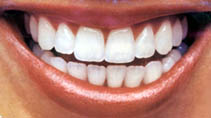|
|
|
![]()
Dental Outlook # 8
© Tomás Seif R. Odontólogo Universidad Central de
Venezuela Master of Science The University of Michigan,
USA e-mail: tseif@cantv.net,
Office numbers: (58-2) 992.02.42, 992.54.31,
992.78.09
Welcome to this section of the Dental Column.
Hopefully all our readers will enjoy it and have the opportunity to learn about the exciting advances and technologies that modern dentistry has to offer.
Do you have bad breath?
|
Millions of people around the world suffer of bad breath (halitosis) in a transient or permanent way. It is well known that bad breath importantly affects social interaction Public polls confirm that the image of individuals with bad breath is negative. Bad breath affects social, sexual and many other activities that involve human interaction. There are several causes that originate this problem and very interesting new therapies to treat it. |
 |
What causes bad breath?
Halitosis or bad breath is caused in healthy individuals by certain bacteria that live in the soft tissues of the mouth such as the gums but specially in the posterior region of the tongue. These bacteria live under a "mucous" layer producing sulfured gases which are responsible for the oral malodor.
None of the available commercial products can reach these bacteria regardless of the frecuence of usage, in the same manner toothbrushes are not very effective either.
Why do some people have bad breath?
Some people have more malodor causing bacteria in their mouths than others. It is well documented that many people suffer from bad breath and are affected socially from this problem. There are around 70 million Americans who have ongoing oral malodor.
Contrary to what people believe, 90% of bad breath does originate in the mouth. This can be demonstrated very easily: the air that is expelled from the nose of a person that suffers from bad breath does not smell bad although the air expelled from the mouth does.
The other 10% of bad breath cases can have different origins like the stomach, troat, infected sinuses, etc.
Other factors that contribute to bad breath are dental and oral soft tissue infections (like infections of the gums). Periodical checkups and professional dental cleanings are very important to avoid bad breath. Nevertheless remember that the primary area of your mouth were bacteria hide and produce bad smelling gases is the posterior area of the tongue.
If your bad breath starts abruptly, increases in a short period of time and/or comes accompanied with fever, cough or any other symptoms, you should visit your physician in order to discard infections or other medical problems.
Some foods and other habits can also contribute to bad breath.
Once you ingest certain foods and liquids like onions, broccoli, garlic, aromatic spices, alcohol, etc., they are incorporated to the bloodstream through the gastric mucous membrane being liberated afterwards to the saliva and the air that comes from the lungs. this can prolong halitosis for up to 72 hours after digesting these substances.
This type of malodor can not be treated up to date with any known product. Pills that claim to act in the stomach to relieve you from bad breath have very little or no effectiveness. The solution obviously is to reduce the frequency of eating and/or drinking this type of substances. Other habit that contributes to bad breath is smoking be it cigars, cigarettes, pipe, etc.
Why commercial products don´t work?
|
Oral rinses, breath sprays, mints and other products only mask bad breath by overriding it momentarily with a certain flavoring agent. Yes, the effect is only transient (15-30 minutes) and therefore these products don't work on a long term basis. Another drawback of the available over the counter rinses is that they usually contain alcohol, which will only irritate and dry the oral soft tissues. |
 |
What is the current treatment for halitosis?
The therapeutical agents that can make a difference are not yet available directly to the public. These products are available to the dentist and then prescribed to the patients or sometimes also available in magazines and direct marketing (in the U.S.A)
Besides good habits of oral hygiene, now there are kits specially formulated to treat halitosis. They contain a special plastic instrument designed for cleaning the posterior area of the tongue (remember that this is were malodor causing bacteria hide) and also patented mouthrinses that contain a substance called chlorine dioxide and other chemicals that reduce residual odors. Once the malodor is controlled, the mouthrinse has to be used twice a day to maintain the results. These systems eliminate bad breath in healthy people virtually in every case.
What is chlorine dixide (ClO2)?
The primary cause of bad breath are the so called "volatile sulfur compounds" (gases) produced by certain oral bacteria. These gases are oxidized and destroyed by chlorine dioxide (CLO2). This chemical is a strong and secure deodorizing-antibacterial agent. It is routinely used in public water systems for purification purposes and it is considered a high tech component in these new mouthwashes.
There are several brands of products that contain chlorine dioxide. It has been shown that if this substance is present in a concentration of at least 10 parts per million, it is highly effective in destroying the gases that cause oral malodor. One of the available products contains a variation of this chemical calling it "activated" chlorine dioxide (ACLO2) . Independent studies demonstrate that this product is the most effective when used properly.
This formulation is activated immediately before use. This assures a fresh mix with a 100% potency. An activated bottle will remain active during 4 to 6 weeks, afterwards it should be discarded. Some other products contain what is called "stabilized" chlorine dioxide, a salt that becomes active only under acidic conditions in the mouth. Laboratory testing shows that the chlorine dioxide in these cases does not become very active. These products only achieve partial degrees of malodor reduction.
It is important to mention that all these mouthwashes don't contain alcohol, so therefore, there is no mucosal irritation.
In conclusion, today the most effective treatment to control halitosis begins with an adequate regime of oral hygiene using special devises designed to clean the posterior areas of the tongue, together with the daily use of special mouthrinses that contain the chemicals described in this article.
I am looking forward to update you with more interesting information about modern dentistry.
Es nuestro interés que la información incluida en esta página sea de su ayuda. Si tiene alguna pregunta puede envíarnos un correo electrónico, o si desea que incluyamos algún tópico en particular en esta sección puede contáctarnos a través de nuestro libro de visitas.
